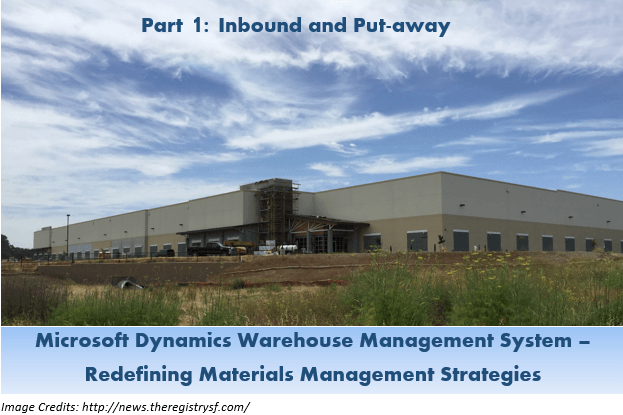July 7, 2015 - by Synoptek
Our offices at Synoptek are abuzz about how impressive the Warehouse Management System (WMS) is in the most recent Microsoft Dynamics AX R3 release. The WMS comes as a standard feature in the Dynamics AX platform and is transforming manufacturers’ materials management strategies for the better. In this three part series, we’ll delve into the sophisticated features of this module and why we’re so excited. As you’ll see in our series of posts, this module is streamlining warehouse processes by redefining warehouse layout, improving visibility into inventory, and as a result, users are seeing real cost reductions and increased customer satisfaction.

In our first post, we’ll dive into the benefits for inbound and put away process; in the second post, we’ll explore the benefits for the picking and pulling process; and, in our final post, we probe the benefits of this module for distribution.
Microsoft Dynamics AX Warehouse Management – Inbound and Put-away Benefits
Receiving and put-away are the first steps of most manufacturing firm’s materials management strategy. Whether receiving items from the dock, the shop floor or quality control, the WMS in Dynamics AX helps firms to put inventory away efficiently, while maximizing warehouse space by automatically identifying optimal storage locations for items based on the characteristics and warehouse zones. Let’s deep dive into some of these key features.
Placement and storage: No more searching or losing track of materials. We’ve seen situations where only a person or a group of people are receiving, as the knowledge gatekeepers for where items are stored. It’s like one person in your house knowing where you store groceries, which can be an issue in a home, let alone in a manufacturing warehouse. Through WMS, you can designate item locations on five different levels of specificity: warehouse, aisle, rack, shelf, and bin while further defining each location based on parameters such as space and pallet type. If some items need special considerations, such as temperature requirements or the rate of turnover, then you can divide the warehouse into zones in order to accommodate these needs.
Inventory Dimensions: You want to make sure you are allocating space correctly when strategizing your materials management. You don’t want to be left with a crawl space for a huge part. The WMS, through your pre-defined requirements, will allow you to control where you can store things of certain dimensions so you maximize the usage of space in your entire warehouse.
Serial and batch number control: With RFID and sophisticated bar-coding you can further ensure the accuracy of your inventory by scanning each item at every stage of its journey, including registering its arrival at the dock. This increases the speed and accuracy of putting away items. Regardless of how many items you need to manage, Dynamics AX is capable of handling high volume orders accurately. We’ve seen this feature as being especially helpful to auto and aerospace manufacturers; they are more effectively able to manage their high number of VIN and serial numbers for parts, which ultimately improves traceability.
Arrival Journals: Through the WMS, you can further manage your inventory by reserving items for customers, receiving advance shipping notifications on incoming product, and seeing your incoming items in inventory as soon as they reach your warehouse. Arrival journals allow you to recreate a complete history of actions and item identifiers by using an audit trail. Through the option of either manual or automatic suggestions of put-away locations, put-away can be managed through use of pallet transport.
RFID and bar-coding: We mentioned that the RFID is sophisticated and gives you accuracy. Some additional details about this features is that it allows you to read and write five different types of bar codes: EAN 128/UCC128, Code 39, Interleaved 2 of 5, Code 128, UPC A, UPC E, EAN 13, and EAN 8. You can also read and write to RIFD-EPC tags. RFID allows you to register pallets and inventory items while controlling them throughout the supply chain. The mobility feature of R3 coupled with the polished bar coding features makes this module dynamic; you can untether yourself from your desktop or laptop and manage inventory at your fingertips.
These are just a few of the many ways Microsoft Dynamics AX can be used for inbound and put-away in the WMS. These features were specifically designed to streamline the manufacturing process and keep you ahead of the competition. Join us for the second installment of this series, when we explore picking and pulling.
Click on the following links to read other parts of the three blog series: